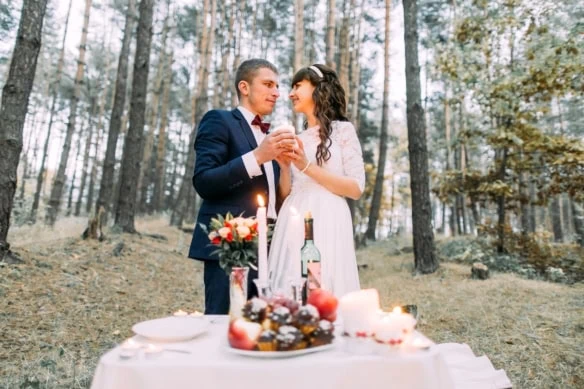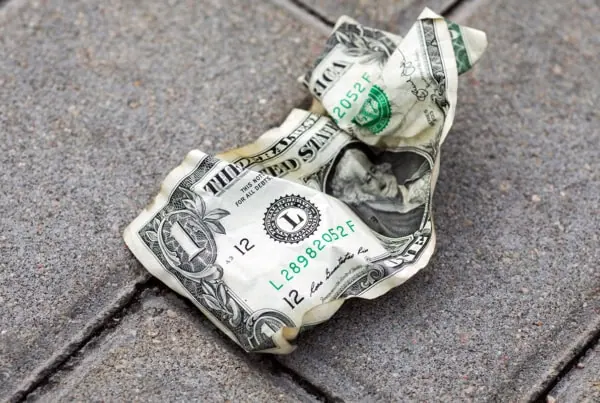Weddings are often the most elaborate and expensive event a person will throw in their lives.
Some people don’t love this idea. Depending on who you talk to or what web forums you frequent, you might have seen people brag about their cheap weddings—and toss in their opinion about how only shallow or financially inept people throw costly events. Conversely, if you scroll through Instagram on the regular, you’ll be bombarded with photos of weddings that cost more than what many people earn in an entire year.
I’m not going to opine on the dollar amount you should spend on your wedding. That’s a highly personal decision that’s largely dependent on your location and the current state of your finances—and frankly, it’s no one else’s business.
But I am going to give you a number of tips if you’d like to keep your wedding costs in check.
If you’ve envisioned a luxurious wedding for as long as you can remember, but you have a strict budget to adhere to, don’t worry, and read on. The following ideas can help you throw a bougie wedding on a budget.
How to Have a Frugal, Yet Fancy, Wedding
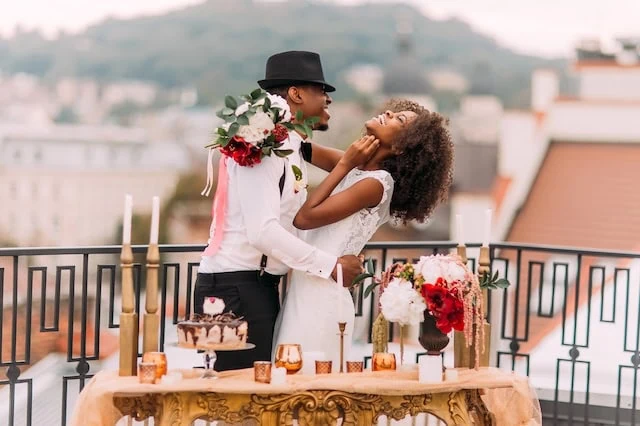
Do you want to feel like a million bucks on your wedding day without actually spending that much?
It’s possible, but it takes some careful planning.
The following tips can help you reduce your wedding costs without feeling like you’re sacrificing everything you want. By simply doing your homework and being forthright about your wedding priorities, you can get a wedding to remember at a price that’ll be easier to forget.
1. Choose Your Top Priorities

Achieving a low overall wedding budget doesn’t mean you have to go low-price on every single aspect of the event. Start by following these three steps to prioritize:
- First, take a few minutes to determine what’s most important to you. Location? Food? Decorations? Photography? How about an open bar so great they don’t remember the other details? You and your future spouse should choose the top two, three, or four factors that you care about most and are willing to put an outsized amount of budget toward.
- Next, cut anything you and your spouse don’t personally care about. For instance, I don’t remember the wedding favors from when my friends have gotten married, so I wouldn’t spend anything on them. Maybe you don’t need to arrive in a fancy limo. Maybe a photobooth makes little sense when you’ll have a photographer (and everyone else has smartphones).
- Last, write down anything that didn’t make the other two lists. This final list represents items you can include in your wedding, but that you’re willing to go low-budget on. Let’s say you want music at your wedding but it’s not a high priority. Rather than hiring a professional DJ, you might instead hire an affordable local band or ask your wedding reception site if you can plug a phone or laptop into the sound system and play your own setlist from Spotify or Apple Music.
2. Keep Your Guest List Small
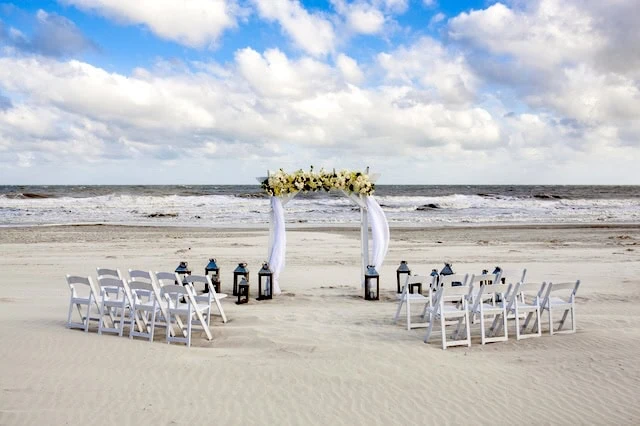
Some wedding expenses, such as the photographer, will cost the same no matter the size of your guest list. However, many costs will rise right alongside the number of invitees.
For instance, a smaller wedding guest list means you can use a smaller reception hall, which is usually more affordable. A smaller space will likely require fewer flowers and other decorations. Fewer people absolutely means you can spend less on catering and alcohol.
In other words: Limiting your guest list is one of the best ways to host a formal affair while keeping your costs intact.
Give time and thought to exactly who you want to invite. Does your entire work department (and their spouses and children) need to be there on your special day? Are you that close with your third cousins? Do you really expect friends you haven’t talked to in years to travel a few hundred miles for your day?
Also, some people send a few invitations to would-be guests that they hope will RSVP “no.” Don’t take the chance—if you truly don’t want them there, don’t invite them at all.
Related: Stop Shrinkflation! 14 Products Affected + Tips to Save Money
3. Doing It Yourself Doesn’t Always Mean You’re Doing It Cheaper

Some budget-conscious couples try to save on wedding costs by DIYing various aspects of the wedding. That could mean decorations, food, even setting up the venue.
But doing it yourself doesn’t necessarily mean the task is more affordable.
For instance: Professionals can often buy items in bulk and thus get prices you simply can’t. There’s labor, too. The same flower wedding arch it takes a florist to do might take you 10 hours—10 hours you might be able to spend picking up an extra shift or two at work, which in turn could pay for professionals to tackle a few wedding to-dos better than you.
There’s also the chance that if something isn’t turning out the way you envisioned it, you might panic at the last minute. If that happens and you’re forced into hiring or buying someone on the spot, you might be looking at even more expensive rates—or you might not be able to find someone at all.
Let’s say you plan to do your own elaborate ‘do even though you rarely style your own hair. Calling a stylist on your wedding day to fix a tangled mess could cost more than hiring someone from the get-go … and that assumes you’ll be able to find a stylist last-minute at all!
4. Research Multiple Vendors

If you’re lucky enough to marry your first high school sweetheart, that’s wonderful! But most people need to date several people before finding “the one.”
And just like marrying the first person you dated might have been a disaster for most people, you shouldn’t necessarily choose the first vendor you find within your budget.
A sleek website with a few handpicked quotes from happy customers might put your mind at ease, but take the time to read reviews on online platforms such as The Knot and Google Reviews. Have a friend or relative with similar tastes? Did you go to a friend’s wedding and loved how it turned out? Consider asking for recommendations that you can vet yourself. You typically only get one shot to get it right, so take the necessary time to ensure you’re hiring skilled, reliable people.
Once you’ve found a few options that are within your budget and have positive reviews, reach out to see who has availability on your desired date. Make sure you fully understand the pricing structure and what’s included in their packages. Some vendors might have upfront pricing while others use lower general prices that eventually climb higher thanks to fees. A surprise expense on one wedding feature might require you to go cheap somewhere else or bust through your spending cap.
5. Don’t Be Afraid to Borrow
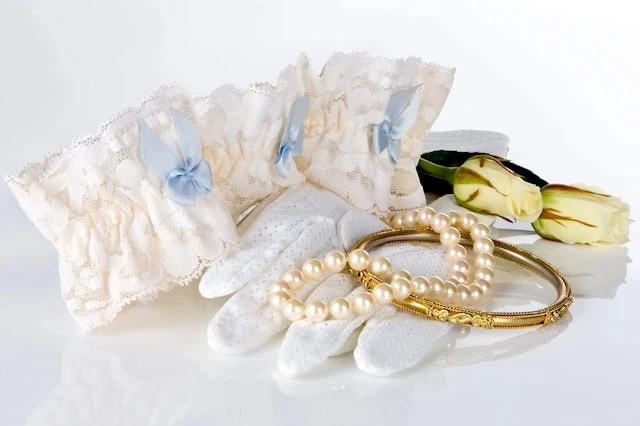
“Something old, something new, something borrowed, something blue.”
Of course, that’s just an old quote, not a hard-and-fast-rule. You can have a lot of somethings borrowed if you want—and doing so can keep costs down.
For instance, one of my closest friends was shocked at how much wedding veils cost, so she borrowed her sister’s. If anyone noticed, they certainly didn’t care (or at least, they certainly didn’t say anything).
A close relative might be willing to lend you diamond earrings or a gold necklace. An aunt or uncle might let you borrow their vintage car for your grand departure. Do your friends share your love of fairy lights? You could borrow those bulbs to create the twinkling scene of your dreams.
With few exceptions, the more you can borrow rather than buy, the better. Just make sure to be understanding and respectful if someone you ask declines your request.
Related: Food Costing a Fortune? Here’s 12 Tips for How to Save Money on Groceries
6. Rentals Can Be Cheaper
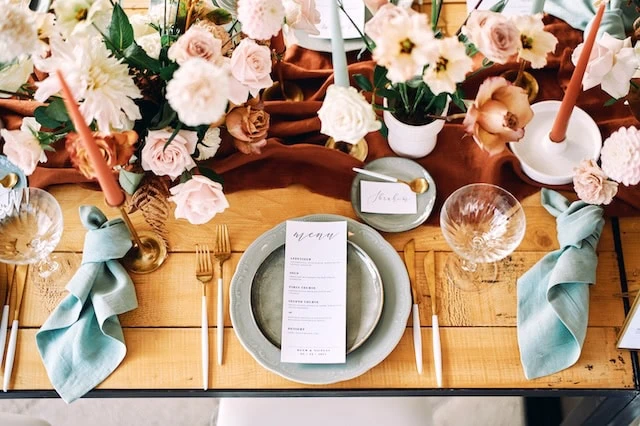
You probably can’t borrow everything, but that doesn’t leave buying as your lone remaining option.
Anything you’re unlikely to use again soon, you should rent. Otherwise, you’re paying more up front, then having to store items you don’t need.
Linen and uncustomized decor pieces are some of the best items to rent, rather than buy. If you aren’t hiring a DJ, you might also rent audio and lighting equipment. Choosing faux over fresh flowers? Rent them! Some grooms and groomsmen choose to rent their tuxes. A bride who wants a decadent wedding dress, rather than something more affordable, might rent a designer dress. Those who enjoy an outfit change between the wedding and ceremony might choose to buy one dress and rent the other.
While you might be tempted to buy everything for your wedding then sell it later, there’s no guarantees you’ll be able to offload everything, or that you’ll get the prices you want. So often, the most frugal choice is renting.
7. Consider Off-Season Months

When people refer to “wedding season,” they typically mean late spring through early fall, though that will differ depending on where you live.
That’s in part because of the weather. I live in Wisconsin and, due to cold, unpredictable weather, most venues only offer outdoor ceremonies from May through September. But it’s also in part because people like to have weddings when school is out—it’s easier for families when kids aren’t finishing projects, playing sports, or performing in plays. And around the country, K-12 school years usually run from late August or early September until late May or early June.
Much in the same way that popular travel destinations are more expensive during “tourist season,” many wedding venues are more expensive during “wedding season.” It’s just classic supply and demand. While researching for my own wedding, venue costs during the wedding season were thousands of dollars higher than they were during the offseason.
Generally speaking, if you don’t need a midsummer wedding, you’ll be better able to afford your dream venue. Some venues will gradually reduce their rates the further away your planned date is from their wedding season date range. Others have a straight cutoff point between wedding season and offseason prices, however, meaning you could change your desired wedding date by a single week and achieve major savings.
Some people also suggest getting married on a weekday to cut down on costs. That can work, but I’d caution against this strategy if you’re having a larger wedding with a lot of guests who need to travel. A weekday wedding might be cheaper for you, but it could be much more expensive for your guests (who would have to take off work). It could also drastically affect attendance levels, making it difficult to hit any catering or alcohol minimums you agreed to (thus unnecessarily raising your per-person costs).
8. Consider a Brunch Reception
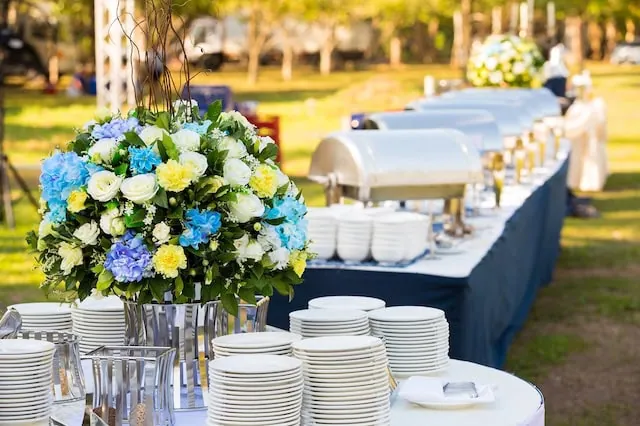
Brunch weddings have gained in popularity over the past few years, and some of that has to do with how much more affordable this option is.
Brunch foods generally cost less than dinner foods. While guests might still enjoy mimosas, a Bloody Mary, and other socially acceptable alcoholic morning drinks, they’re less likely to drink as much in the morning or early afternoon as they would at night, which could significantly cut your alcohol costs. Rather than an elaborate and expensive wedding cake, brunch weddings might have cinnamon rolls, scones, and other sweet baked treats.
You also might pay substantially less for your venue if you opt to do your brunch on a Sunday, which tends to be less in-demand than a Saturday. Even if your event is on a Saturday, it might be cheaper if your wedding leaves time for another couple’s evening reception that night. Moreover, a brunch reception has a different vibe—one that might be better served by skipping an expensive DJ and their equipment, and instead subbing in a solo instrumentalist or even your own playlist in the background.
Related: Retired But Too Young for Medicare? Health Insurance for Early Retirees
9. Reduce (or Eliminate) Paper Costs

“It’s just paper. How much could it cost?”
Wedding invitation prices might be a lot higher than you think. According to The Knot 2025 Real Weddings Study, couples spend an average of $518 on wedding-related papers, which can include save-the-dates, invitations, programs, and similar papers.
If that cost is worth it to you, pay it. But if you’d prefer to spend less money here so you can allocate more to another priority, you have options.
One way to cut down is by skipping save-the-dates. The majority (if not all) of your guests will already have heard your wedding date through the grapevine before their save-the-dates roll in. Many people quickly toss these after they arrive. So you might just choose to limit your physical mail to the actual invitations.
You can also opt for digital invitations. Digital invitations cost far less, and you can include a link to a wedding website with all the information they’d need and an option for guests to RSVP. In addition to being more affordable, digital invites are more eco-friendly and (if you planned on doing written invitations yourself) can save you time.
10. Have a Friend or Family Member as Officiant
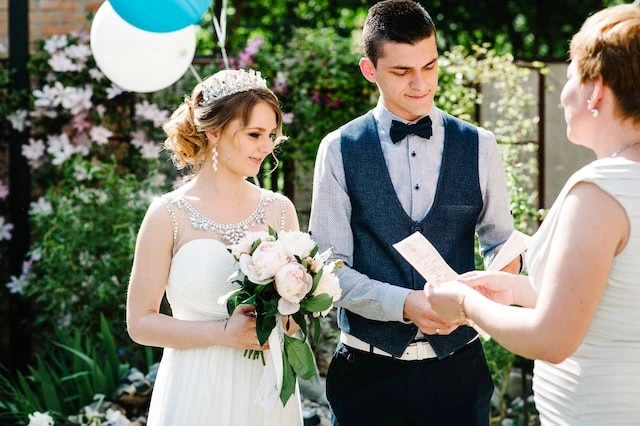
Regardless of whether your wedding is a religious affair, a wedding officiant makes your marriage official. Per the aforementioned The Knot wedding study, the average cost of hiring a wedding officiant is $240.
That’s not a major expense, but it’s still one that’s easily cut and can free up money for other parts of your wedding.
If your friend or family member isn’t already ordained, the process is free! One option is the American Marriage Ministries—a non-denominational church that allows people to get ordained online.
Besides saving you money, having a loved one be your officiant can make your ceremony feel extra special.




